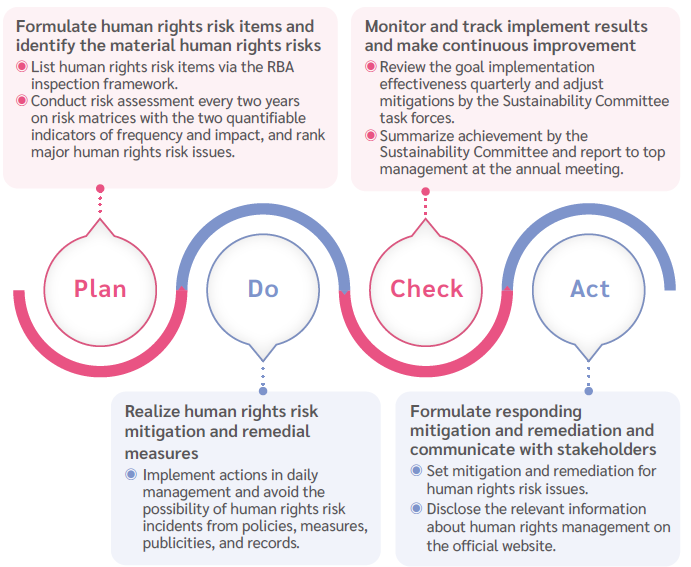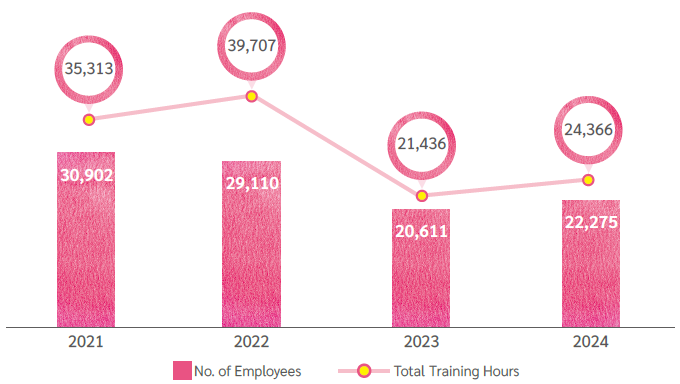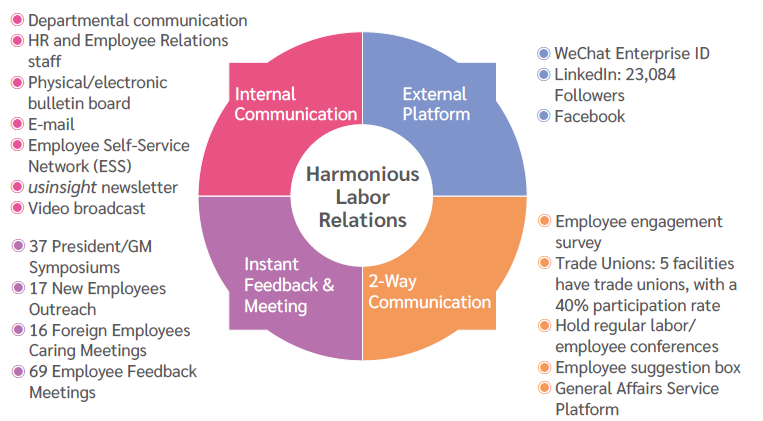
Inclusive Workplace
Human Rights
USI supports, respects, and is committed to human rights as defined in Principles 1 and 2 in the United Nations (UN) Global Compact, the Universal Declaration of Human Rights, the UN Guiding Principles on Business and Human Rights, the International Labor Organization's Declaration of Fundamental Principles and Rights at Work, the USI Code of Business Conduct and Ethics and the laws of the countries in which we operate. Being a member of the Responsible Business Alliance (RBA), we adopt its Code of Conduct in our global operations to enforce our commitment to protecting human rights. We also protect and promote human rights with our employees, joint ventures, contractors, business partners (suppliers, clients), local governments, communities and other stakeholders.
Due Diligence
USI understands and manages human rights issues in a responsible manner, focusing on employees and suppliers and adhering to the concepts of the PDCA management process and continuous improvement. The corresponding taskforce teams under the Sustainability Committee identify, evaluate, monitor, prevent, and reduce human rights impacts through the due diligence process. We disclose the assessment results on the official website in the form of a Due Diligence Report. The performance indicators of the Labor, ethics, environment, safety and health are reviewed in the quarterly Sustainability Committee meetings. The execution results are summarized and submitted to the Sustainability Committee and reported to the top management team annually.
RBA Risk Assessment Mechanism
- To all facilities and new business relationships, we arrange cross-site mutual audits every year to ensure full compliance with normative standards. If there are any non-compliant items, an improvement plan needs to be proposed and make improvements within the requested period. We adopt the RBA management framework to implement RBA Self-Assessment Questionnaire (SAQ) internally every year and entrust external third-party institutions with special training in social and environmental audits to provide RBA Validated Assessment Program (VAP) audit services for risk management every 2 years to identify issues and objects that are vulnerable to human rights risks, formulate measures, and continue to make improvements.
- For our joint venture human rights risk assessment, it is required to conduct human rights risk identification every year. Those human rights risk issues listed in their sustainability reports, or the RBA SAQ human rights risk identification results are necessary to formulate corresponding improvement plans and track their mitigations.
- For the supplier human rights risk assessment, it is to conduct a human rights risk assessment on the annual Tier 1 suppliers and conduct written document reviews, on-site audits, and RBA VAP to further find out which high risks that suppliers may face and continuously track and improve the effectiveness of their countermeasures for different risks.
- We have established investigation and employee reporting mechanisms and complaint channels to manage employees’ complaints and ensure the implementation of human rights policies and avoid incidents that endanger human rights.
Due Diligence Process:

Human Rights Risk Mitigation & Remediation:
We conduct RBA SAQ and VAP human rights risk assessments of the global manufacturing facilities, as well as the statistics of employee complaint cases, identify the risks of each factory and propose corresponding mitigation plans. The 2024 human rights due diligence results showed that the Company had no violations such as employing child labor, subjecting young workers to work that endangers their health or safety, forced or compulsory labor, infringing on the rights of indigenous peoples, or any form of discrimination. In addition, the RBA SAQ assessment results of each facility were classified as low/medium-risk level, and the VAP results for all Facilities were scored above 175, and no priority findings were found. Working Hours and Wages and Benefits were identified as labor-related human rights issues with high exposure risk. Starting with human rights awareness trainings, recruiting sufficient manpower, and managing working hours, etc., we promoted publicity to ensure our colleagues understand the Company’s management system from a legal perspective.
USI remains committed to human rights protection by promoting awareness and reducing related risks through ongoing training. In 2024, the average duration of human rights-related training per employee was 1.1 hours, totaling 24,366 hours across 22,275 employees. All employees completed the required human rights training, achieving a 100% completion rate.
Human Rights Training Participant Numbers and Training Hours:

USI's human rights policies are implemented as follows:
- Employee Rights: Build a workplace that is diverse and inclusive, free from discrimination and harassment, and has equal job opportunities
- All USI facilities have established Work Rules to ensure employees understand their rights and responsibilities.
- Each facility also follows standardized Recruitment Guidelines to ensure fair, inclusive, and non-discriminatory hiring practices. Candidates are selected based on merit, helping USI attract a diverse range of talent.
- To promote our Policy on Humane Treatment in the Workplace, USI has created a dedicated intranet section that reflects our culture of respect, inclusion, and non-discrimination. This section also provides grievance channels to ensure all employees are protected from physical and mental harm while at work.
- Employee union: Respect employees' freedom of association
- Now, in addition to the Nantou Facility and the new setting Vietnam Facility, which have not established trade unions, the Zhangjiang Facility, Jinqiao Facility, Huizhou Facility, Kunshan Facility, and Mexico Facility have established their trade unions, and group agreements are signed with the trade unions. Employees participating in the trade union enjoy the protection of group agreements. The group agreement coverage rate is around 58% (Group agreement coverage rate = Number of employees covered by the group agreement in the facility area ÷ the number of total employees at the end of the year × 100%).
| Unit | 2021 | 2022 | 2023 | 2024 | |
| No. of emloyees in Unions | # | 6,350 | 5,901 | 6,887 | 6,608 |
| Join Unions Rate | % | 35.1 | 35.4 | 40.4 | 44.1 |
- Employee communication: Establish a positive and harmonious labor-management relationship
- We held 139 employee communication seminars, which vigorously push and disseminate communication messages through various media and strengthen the promotion of information on internal and external reporting and feedback channels when the messages are conveyed.
- We received 139 employee feedback submissions, and all of which were processed and addressed.



